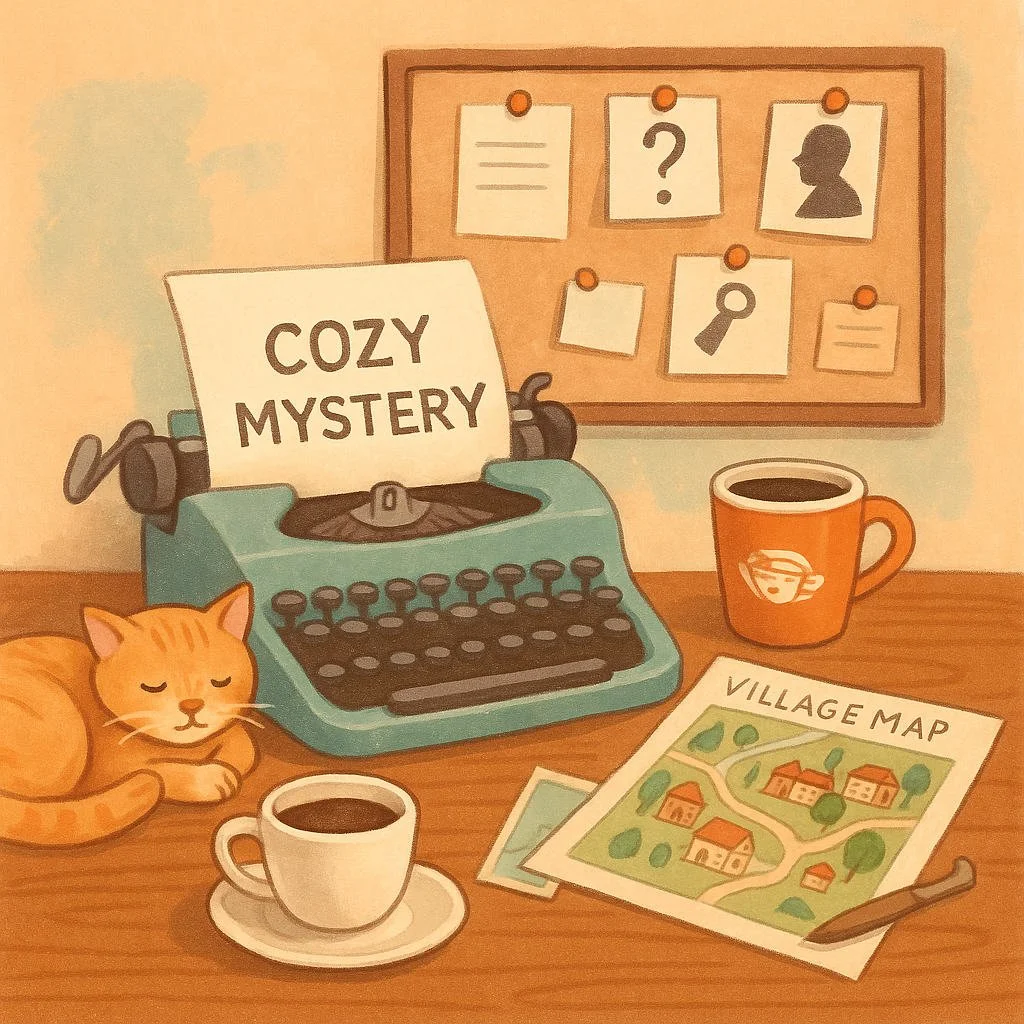How to Write a Cozy Mystery
What makes a mystery “cozy”?
Tone: Warm, witty, comfort-forward; stakes are personal and community-based, not apocalyptic.
Violence: Occurs off-page or is fade-to-black; no gore, torture, or graphic autopsies.
Language/sex: Clean language; romance stays sweet or closed-door.
Sleuth: A relatable amateur (baker, librarian, teacher, crafter, barista, bookseller…) with a practical skill that helps investigation.
Setting: A contained, charming community (small town, village, island, cul-de-sac, theme shop) full of recurring characters.
Series DNA: Readers return for the ensemble (pet sidekicks, best friend, grumpy cop, quirky townies) as much as the puzzle.
Cozy mystery promise (what readers expect)
A puzzly whodunit with fair play clues.
A comforting world you want to re-visit (food, crafts, cats, community).
A satisfying reveal where the sleuth earns the answer, not the author.
Closure: culprit caught, community restored, emotional grace notes at the end.
Core cast (build your ensemble)
Amateur Sleuth (AS)
Day job intersects with clues (cataloging rare books, baking custom cakes, repairing clocks, dog grooming).
Internal drive (protect my shop, clear a friend, prove myself, defend my town).
Sidekick/Confidant
Provides banter, sanity checks, access (tech-savvy teen, gossip-rich aunt, vet nurse).
Can “discover” informal info the sleuth can’t.
Love Interest (often a Cop/Reporter/Firefighter/Handyman)
Romantic tension, professional friction. Keeps boundaries (no evidence theft).
Authority Figure (usually a Detective/Chief)
Opposes or tolerates the AS; conflict creates stakes and humor.
Victim
Tied to the community; their secrets create suspect pathways.
Five Suspects (minimum three):
Each has Motive, Means, Opportunity (MMO) + a personal secret.
Give each a distinct tell (nervous habit, scent, wardrobe quirk) and a plausible alibi.
Optional delights
Pet familiar (cat/dog/parrot) who “finds” clue crumbs.
Hobby cohort (knitting circle, trivia team, church choir, gaming guild) as gossip engine.
Motive menu (pick 1–2 for your culprit)
Money/Greed: inheritance, embezzlement, real estate deal.
Revenge/Old Wound: school bullying, past affair, academic sabotage.
Reputation: plagiarism, career-destroying secret, social ruin.
Love/Jealousy: triangle, possessiveness, betrayal.
Cover-Up: earlier crime, environmental violation, fraud.
Status/Power: board elections, small-town politics, HOA drama.
Tropes that reliably delight (sprinkle, don’t dump)
Newcomer inherits shop/home → learns town lore.
Grumpy cop vs. sunshine sleuth.
Festival/competition deadline (pumpkin fair, chili cook-off, dog show).
Locked-room-ish constraints (snowstorm, ferry outage, blackout).
Secret society/club with old rules.
Recipe/DIY inserts between chapters (optional but cozy).
The fair-play rule (how to hide in plain sight)
Plant 3–7 true clues readers could spot on a first read.
Pair each true clue with a misdirection (red herring, innocuous explanation).
Make the linchpin clue visible early; its meaning flips late.
Clue & red herring toolkit
True clue types
Physical: mislabeled spice jar, missing button, unique footprint, swapped book jacket.
Behavioral: sudden allergy, wrong handedness, too-detailed story, contradictory timeline.
Textual: receipt, calendar, menu note, library hold slip.
Expertise gap: culprit pretends to be a baker but mispronounces “lamination.”
Red herrings
Coincidence: suspect had a fight but unrelated to murder.
Gossip distortion: town rumor half-true.
Innocent crime: petty theft makes someone act guilty.
Decoy motive: a loud feud hides a quiet embezzlement.
A practical 15-beat cozy outline (60–75k words)
Hook (1–2k): Sleuth in daily life + unique setting charm.
Inciting Incident: Body discovered; sleuth entangled (blamed, locked in, finds first clue).
Refusal/Warning: Authority says “Don’t meddle.” Sleuth promises to bake/behave. (Lies!)
First Foray: Interview 1–2 suspects; collect gossip; find Clue #1 + Red Herring #1.
Subplot Spark: Shop crisis, festival prep, family issue, budding romance.
Suspect Carousel: Three more suspects introduced; Clue #2–3.
False Lead Win: Sleuth “solves” the wrong angle; stakes briefly drop.
Midpoint Twist: New body, big reveal, or alibi collapse. Personal stakes spike.
Pushback: Authority tightens; a friend is arrested or shop nearly closes.
Deep Dive: Re-examine evidence; spot the odd detail you planted in Act 1.
Danger Close: Sleuth confronts the wrong suspect → scare or escape.
Pattern Clicks: Motive math lines up; Clue #4–5 reframed.
Showdown Setup: Sleuth lures all to a plausible gathering (tasting, meeting, rehearsal).
Reveal & Turn: Sleuth explains chain of clues; culprit breaks in character and slips.
Afterglow: Arrest, community restored, romance beat, recipe/club scene, hook for Book 2.
Scene template (rinse and repeat)
Goal: What does the sleuth want from this scene (an alibi, access, object)?
Obstacle: Who/what stands in the way (gatekeeper, policy, weather, pet chaos)?
Beat of charm: Food, craft, pet, town color.
Discovery: Clue or herring (label each in your outline!).
Turn: New question, complication, or suspect reaction.
Exit hook: A line or mini-mystery that propels to next scene.
Word count map (typical)
Act I (20–25k): Introduce ensemble, plant 2–3 clues.
Act II (25–35k): Suspect rounds, midpoint twist, biggest herring.
Act III (15–20k): Synthesis, trap, reveal, restoration.
Planting the solution (without cheating)
Put the decisive clue in Act I as a casual detail (label color, menu change, note on bulletin board).
In Act II, invert its meaning with a herring.
In Act III, sleuth reframes it with new context (science, schedule, town tradition).
Dialogue that carries clues (but sounds natural)
Use gossip cadence: people half-remember, exaggerate, contradict—embed the truth inside the noise.
Give each suspect a lexical tic (malapropism, idiom, regionalism) that later betrays knowledge they shouldn’t have.
Setting as a clue engine
Shops: inventory logs, special orders, vendor delivery times.
Libraries/archives: hold slips, due-date history, event rosters.
Kitchens/cafés: allergen charts, rotation labels, knife roll ownership.
Craft studios: dye lots, yarn weights, unique tools.
Cozy romance (sweet and subplotty)
Aim for mutual competence: both characters help the case in their lane.
Use slow-burn beats: coffee refills → rescue in snowstorm → post-reveal porch talk.
Keep it conflict-light and affirming; banter > angst.
Pacing: comfort × momentum
Alternate investigation scenes with cozy beats (pet antics, recipe test, town festival).
End chapters on questions or reversals, not breakfast descriptions.
First-book checklist (before you draft)
Sleuth’s day job meaningfully intersects with clues.
Five suspects with true MMO + one secret each.
One personal stake (shop lease, friend accused, event deadline).
3–7 fair-play clues paired with misdirects.
A reveal location that naturally gathers everyone.
Series seeds: an unsolved personal question or town arc.
Draft fast with 10× “micro beats” (repeat for 20–30 chapters)
Open on a goal.
Add a cozy color beat.
Interrogate or eavesdrop.
Plant clue/herring.
Raise a personal stake.
Obstacle lands.
Pet/food/craft grace note.
Decision to pursue X.
Transition hook line.
Hard scene cut.
Revision pass (surgical checklist)
Clue audit: Can a fair reader solve it? Are clues visible before the reveal?
Herring audit: Remove any that require characters to act stupid.
Culprit psychology: Motive holds under scrutiny; no “because villain.”
Voice polish: Cut adverbs, sharpen banter, keep warmth.
Continuity: Weather, timelines, shop hours, pet feeding—no dropped threads.
Sensitivity & respect: Quirky ≠ caricature. Punch up, not down.
Line candy: 1 memorable simile or micro-joke per chapter.
Comfort quotient: Food/craft/pet content sprinkled throughout, especially after darker beats.
Recipe/DIY interludes (optional but beloved)
One recipe or craft tip every 3–5 chapters.
Tie it to plot (“This spice mix hides saffron; the culprit couldn’t afford it”).
Series planning (think three books ahead)
Seasonal wheel: Autumn fair → Holiday market → Winter carnival → Spring garden tour.
Recurring antagonists: HOA tyrant, rival shop owner, snide food critic.
Slow-burn romance: Define mileposts (first confessional, first kiss, first trip).
Town arc: A development project threatens Main Street; resolution at Book 3.
Titles readers click
Pun + Noun: Batter Off Dead, Espresso Yourself, A Purr-fect Alibi.
Place + Event: Murder at Maple Lane Markets, Midwinter Malice in Marigold Bay.
Object + Crime: The Lace & Larceny Ledger, The Sourdough Sabotage.
Query/pitch snapshot (for later)
Logline formula: When [inciting incident], a [day job + quirk] must solve [distinctive crime] before [deadline], or [personal stake] collapses—if the [unique setting hook] doesn’t get there first.
Marketing that matches cozy readers
Series logo: a simple motif (teacup, pawprint, spool of thread).
Newsletter magnet: a prequel short where the pet “solves” a micro-mystery.
Back-of-book recipe/craft card as shareable extra.
ARC team: recruit from craft clubs and library circles.
Consistency: release cadence beats raw ads for cozies.
7-day sprint plan (from zero to solid outline)
Day 1: Pick town, sleuth, shop; list 5 suspects + motives.
Day 2: Build suspect grid; choose linchpin clue.
Day 3: Draft 15-beat outline; decide reveal venue.
Day 4: Sketch 10 scene cards (goal/obstacle/clue/hook).
Day 5: Write Chapters 1–3 (body by end of Ch. 2).
Day 6: Write two suspect interviews + one cozy interlude.
Day 7: Clue/herring audit; refine midpoint twist; list 5 chapter end-hooks.
Mini-examples (plug-and-play)
Clue: The victim’s “gluten-free” cupcake has a dusting pattern only from wheat flour sieves.
Herring: The rival baker with motive actually uses pre-sifted blends—no sieves in her shop.
Flip: The town historian (culprit) borrowed the sleuth’s sieve during a “heritage bake demo.”
Clue: Signed first editions are reorganized wrong—only someone left-handed would stack them that way given the shelf constraints.
Herring: The southpaw poet says “guilty as charged” but meant guilty of reorganizing, not murder.
Cozy ethics (non-negotiables)
Respect for small-town life; no sneering at working folks.
Queer, immigrant, and disabled characters can be part of community without being plot devices.
Justice with compassion: endings can include restorative notes when appropriate.
TL;DR (finally)
Promise comfort + puzzle: clean tone, off-page violence, lovable ensemble, fair-play clues.
Build a suspect grid (MMO + secret), plant 3–7 real clues, pair each with a red herring.
Follow a 15-beat outline to keep momentum and warmth balanced.
Use a scene template (goal/obstacle/cozy beat/discovery/turn/hook).
Revise with a clue & herring audit, sharpen voice, ensure compassionate community vibes.
Think series from page one: seasonal arcs, recurring townies, slow-burn romance, consistent titles.
Write the town readers want to live in—and a sleuth they want to have coffee with.









